Saint Joseph Church and Seminary


MACAO, 1983, Architectural series, Scott 473
MACAO, 2005, Cultural Heritage of Humanity, Scott 1173a
JESUIT
INSTITUTIONS Page 1 of 2 |
Saint Joseph Church and Seminary

MACAO, 1983, Architectural series, Scott 473
MACAO, 2005, Cultural Heritage of Humanity, Scott 1173a
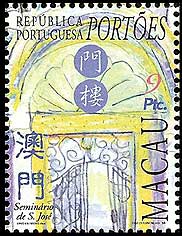

MACAO, 1998, the souvenir sheet (see below) of an issue on gates shows St. Joseph's entrance, Scott 920
MACAO, 2010, issue honoring St. Augustine Square shows seminary and church,
Scott 1315d


The souvenir sheet shows the facade of the seminary and is also available with a gold overprint:
"Amizade Luso-Chinesa/Festival de Macao" and Chinese text, Scott 920a
Jesuits founded St. Joseph Seminary in 1728 to train both foreigners and young men of Macao as missionaries for China. St. Joseph Seminary Church (seen on this stamp) was completed in 1758, the same year when Pombal had the Jesuits removed and imprisoned. The Vincentians took over the school in 1784 and under their tenure it was granted the title "Royal Seminary." It later became a university. In 1998 and 1999, the church underwent restoration work, returning the building to its original appearance. It was reopened to the public in December 1999.
Saint Lawrence Church
MACAO, 2013, as part of its Christmas issue an angel in front of St. Lawrence Church , originally built by Jesuits in 1602, Scott 1399
Built originally of wood in the 1560 by the Jesuits, rebuilt in clay in 1618 and finally reconstructed in stone around 1803, St. Lawrence Church is one of the three oldest churches in Macao. Its present appearance and scale was acquired in 1846. Situated on a highland on the southern coastline of Macao overlooking the sea, families of Portuguese sailors used to gather on the front steps of the church to pray and wait for their return, hence it was given the name Feng Shun Tang (Hall of the Soothing Winds). It is a neoclassical structure, with subtle Baroque decorative inspirations, but with a fine Chinese tile roof and oriental ornamentation indoors.

MACAO and ÅLAND, 2010, Church Windows joint issue; souvenir sheet's selvage shows at the left the interior of the Church of St. Lawrence.
The stamps of Macao and FDI cancel (below) show a window from St. Lawrence Church of Lawrence being appointed deacon by St. Sixtus II, Scott Aland 307; Macao 1317-1318

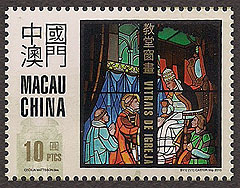
CHINA, 1997, Scott 2814Among Macao's historic structures the chief and most symbolic of Macao is the great ruined facade of the Church of the Mother of God, the largest Christian church in Asia. It was built in 1602 according to the plans of a Jesuit architect, Blessed Carlo Spinola, SJ adjacent to the Jesuit College of St. Paul, the first Western college in the Far East, the printing press of which produced many important books. The church suffered a number of fires, the last in 1835 which left only the facade of carved stone. This had been built in 1620-27 with the assistance of Japanese Christian artisans who had fled from feudal persecution in Nagasaki. The remains of both church and college are known collectively as the Ruins of St. Paul's, and the name is sometimes mistakenly thought to refer to the church alone. Together they are a reminder of the role of the Jesuits in bringing Christianity to the Far East.

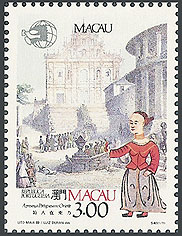
MACAO, 1983, architectural series, Scott 475
MACAO, 1989, a mini-sheet honoring Portuguese influence in Asia pictured St. Paul's, Scott 610a
The background image is Religious Procession at the S. Paul’s Church Ruins, Macao (1858)
drawn by William Heine, engraved by P.S. Duval & Co., New York.

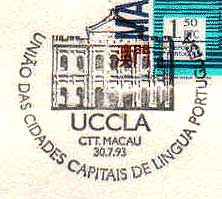
MACAO, 1993, series on Portuguese speaking capital cities, Scott 703, and its FDI cancel
MACAO, 1995, from a series: Macao as seen by the artist Lio Man Cheong, Scott 763

MACAO, 1997, Scott 879
PORTUGAL, 1997, Scott 2167
MACAO, 1997, Kwok Se's painting of Macao, Scott 864


NAMIBIA, 1997, celebrating the return of Macao to China in 1999, mini-sheets
of Scott 889 and 890
St. Paul's is seen in the first sheet within the hollow U of MACAU


NAMIBIA, 1997, celebrating the return of Macao to China in 1999, souvenir
sheets, Scott 891-892

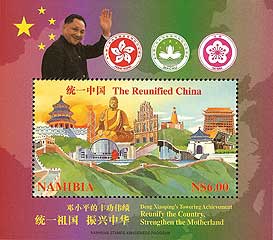
NAMIBIA, 1997, celebrating the reunification of China, Scott 892a-893


MACAO, 1999, the return of Macao to China, Scott 1012c
GAMBIA, 1999, the return of Macao to China, Scott 2166c